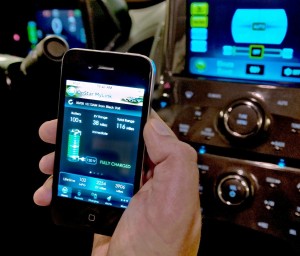
Auto companies remain committed to expanding vehicle electronics and web connectivity.
OnStar is debuting next week new services and technologies for its 6 million subscribers as part of a “realignment” of the company’s long-term strategy.
The GM subsidiary plans to offer what it calls innovations that “significantly increase drivers’ in-car connection,” on the eve of the second annual Distracted Driving summit that is being convened next week in Washington, DC by U.S. Department of Transportation Secretary Ray LaHood.
OnStar executives did not respond to queries about its participation in the meetings. There are no specific public data that show to what extent, if any, OnStar users are part of deadly DD.
LaHood has repeatedly criticized the growing use of electronics in automobiles, but is powerless to regulate it. The National Highway Traffic Safety Administration (part of DOT) is prohibited by the U.S. Congress from promulgating national regulations concerning distracted driving; so LaHood has been using his “bully pulpit” to oppose the well-financed auto, electronics and cell phone lobbies whose companies’ devices are enabling almost 6,000 deaths each year and more than 500,000 injuries.
Simultaneous events held in New York, Austin, San Francisco and Miami yesterday gave OnStar subscribers a first look at new technologies possible through the ninth generation hardware, including in-car social media interactions that are being tested.
“With the extremely high awareness and respect for the OnStar brand, we’ve created a long-term vision that includes new in-vehicle hardware, an all-new IT infrastructure and a host of new partnerships and services that provide the basis for growth,” said OnStar President Chris Preuss.
If implemented, Audio Facebook Updates would allow subscribers to verbally update their Facebook status message through audio recordings and/or listen to their most recent news feed messages through the OnStar Virtual Advisor service.
OnStar also revealed beta tests for voice-based SMS (short message service), which would enable customers to have their text messages read to them using Bluetooth.
The Bluetooth technology allows users to connect their mobile device to their vehicle and receive automated text messages. With a one button press (on the steering wheel), users can reply to a text by verbally selecting a preset response.
More than 100 million people each day are now engaging in dangerous distracted driving behavior. Particularly lethal is the widespread use of cell phones. The issue is not the type of phone a driver uses, rather it is the distraction caused by the conversation. In spite of auto industry assertions, the fact is that hands-free devices do not make cell phones any safer. Several studies indicate that the principle risk is the cognitive distraction of anything that diverts attention while driving.
Also announced was OnStar MyLink, a sub-brand for mobile phone applications. Chevrolet, Buick, GMC and Cadillac mobile apps powered by OnStar will allow owners to remotely activate all functions available on a traditional key fob, including remote start, horn and lights and door locks and unlocks securely from some smartphones. Versions have already been shown for the Chevrolet Volt electric vehicle and the all-new Chevrolet Cruze compact sedan.
A New Marketing Campaign
OnStar also revealed a new marketing campaign for its new business strategy.
“The new campaign retains all of the core strengths of safety and security that OnStar is known for, but also adds the idea of powerfully simple connectivity,” said OnStar Chief Marketing Officer Sam Mancuso.
“The creative showcases how we provide our customers connectivity to all the things that matter most to them, like family, friends, social media tools and our OnStar Advisors,” said Mancuso
The ad campaign, created by OnStar’s agency Campbell-Ewald, will focus on the theme “Live On – Safely connecting you in ways you never thought possible.” Print, broadcast and online executions of the campaign launch Monday, Sept. 20.
Congress is showing no interest on telling voters to stop using cell phones during an election year when all incumbents face ousting from angry voters. Auto companies have their own conflicts of financial interest in this area, of course, as they compete with each other to add more electronic devices to equipment lists. (See BMW to Offer Incoming E-Mail with Voice Output or Smart Phones Add to Distracted Driving Epidemic)
How this all sorts out in the public policy arena remains to be seen.
A recent AAA Foundation survey found two out of three drivers mistakenly believe using a hands-free cell phone is safer than talking on a hand-held device. In this survey, the use of a hands-free cell phone was the only behavior that more than half of all drivers rated as acceptable, yet numerous other scientific studies have shown it is equally as dangerous as talking on a hand-held phone, both quadruple your risk of being in a crash.
However, LaHood in private meetings with automakers this year has made it clear that he will not drop the issue, insiders say.

>> “significantly increase drivers’ in-car connection”
Picking that as pull-quote for comment makes me feel cheap. It’s too easy.
Do we dare do anything to “significantly increase” drivers’ in car connection? They should have an out-in-front-of-the-car-on-the-road-where-important-stuff-is-happening-every-second connection”?
They want a snappy line to sell that service. I want them locked in the trunk if this is their idea of automotive innovation.
Lest anybody suspect me of being a techno-Neanderthal, I am a degreed Electronics Engineer who LOVES this ‘tron stuff. I know it can be misplaced and misused.
JM
As someone who once navigated in the air with a compass, ball and stop watch – or dead reckoning – I love electronics too, particularly GPS.
However, “dead” takes on a whole new negative meaning when applied to Distracted Driving.
Love it. Good one. I’m also a sailor!!!
JM